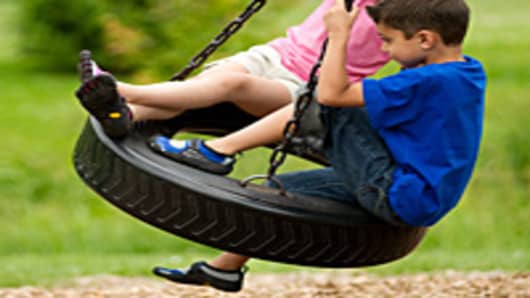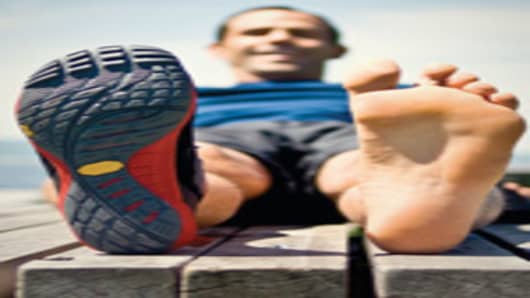There's a new ugly shoe trend, and if you haven't seen it yet, chances are you will soon.
Buoyed up by the popularity of barefoot running, running shoes that provide the foot with minimal support to allow for more "natural" running have gained a cult following. But now it appears that these shoes, which include brands such as Vibram's FiveFingers shoes, are being worn by consumers who aren't hardcore barefoot runners.
They're being spotted in larger numbers at the gym, in yoga classes, at the supermarket, and even on line at Walt Disney World . And Vibram plans to bring additional styles to market this fall that aren't designed with exercise in mind, but instead for other situations such as going to office.
Sure, there have been other ugly shoe crazes in the past. Think about Ugg boots and Crocs , not to mention Birkenstocks and FitFlops. But Vibram makes a claim the others don't—its FiveFingers shoes can help the wearer get back to more "natural" running and walking. Some who have worn the shoes claim they have helped alleviate back pain and other injuries.
"Vibram's product fundamentally changes how consumers think about shoes, and for that reason it's not some kind of sideshow act in the mold of Crocs classic and (Sketchers) Shape-Ups," said Brian Sozzi, an analyst at Wall Street Strategies.
The idea is that once you get hooked on a shoe that promotes more "natural" walking, why would you want to put your feet back into more conventional shoes?
The shoes have their critics, who say the shoes make their wearers look like frogs or aliens, or are somehow "feetier than feet." Others say it's easy to get injured in the shoes if you don't take the time to condition your body.
But FiveFingers' extraordinary sales growth shows there is demand. From 2006 to 2010, Vibram has tripled sales of its FiveFingers shoes nearly every year. Last year, sales grew even more. So much so that this year, the company expects its sales will be 10-times what they were in 2009, according to company spokeswoman Georgia Shaw. (As a private company, Vibram declined to provide more specific sales data.)
"There was a time when we could not keep up with demand," Shaw said, explaining that the company never anticipated the scale of the surging interest.
"We actually thought we were taking quite a bit of risk," she said, referring to the actions the company took as demand picked up. Five factories were added, warehouse capacity was increased, and the company's staff doubled.
"It wasn't a bad position to be in," she said. "People were very excited...(but) you want to be able to meet demand and satisfy consumers."
The main driver of the trend has been advocates of barefoot running. They include author Christopher McDougall who wrote Born to Runas well as Dan Lieberman, an anthropologist at Harvard University.
Lieberman's research has shown that runners in shoes tend to land on their heels first, while barefoot runners land farther forward, either on the ball of their foot or somewhere in the middle, and then their heels come down with much less force than the heel-strike runners. Their stride is also quicker and shorter.
Lieberman suggests the second way is much more efficient and more in-tune with how human bodies evolved.
The idea of minimal support shoes—which include products such as Nike's Free, Fila's Skele-toes,New Balance'sMinimus and Wolverine Worldwide's Merrellbarefoot collection, among others— is to mimic a more natural running stride while still providing the foot with protection.
"Our consumers are our very best advocate," Shaw said. "They become almost brand ambassadors and evangalists for the product. They have created fan sites and formed fitness groups around the product."
And it's true when you speak with runners who have made the switch. There is an enthusiastic zeal in their voices.
But trend may be at a point where it's broadening from the hardcore fan base because of its unique look.
"They're the kind of funny-looking shoes that make you smile," said Danny Wasserman, president and owner of TipTop Shoes in New York City. Tip Top was one of the first retailers to carry the Vibram shoes. People love to gawk at displays with the shoes, he said.
Skele-toes is the only brand that comes close to the "hobbit" look of Vibram's, except Fila has four toe compartments (the last two toes slide in together).
Notably, Fila also doesn't promote running in their shoes, which supports the notion that more consumers would like to go "barefoot" in their everyday lives.
Vibram and Merrell also make designs that are suitable for hiking.
Shaw said the new competition helps to validate the claims the company is making. Vibram also benefits when consumers opt to buy some of the other brands because the company often makes the soles that are placed in those shoes. (The Merrell ones, for example, are made by Vibram.)
That's not to say that consumers shouldn't be cautious. Vibram advocates that consumers switch to their shoes gradually so that muscles in the foot and leg can adapt to them.
"It's like uncasting your foot," Shaw said. "Think of someone who's leg has been broken, and is in a cast for several weeks. The skin is clammy, the muscles are atrophied."
Questions? Comments? Email us at consumernation@cnbc.com. Follow Christina Cheddar Berk on Twitter @ccheddarberk.






